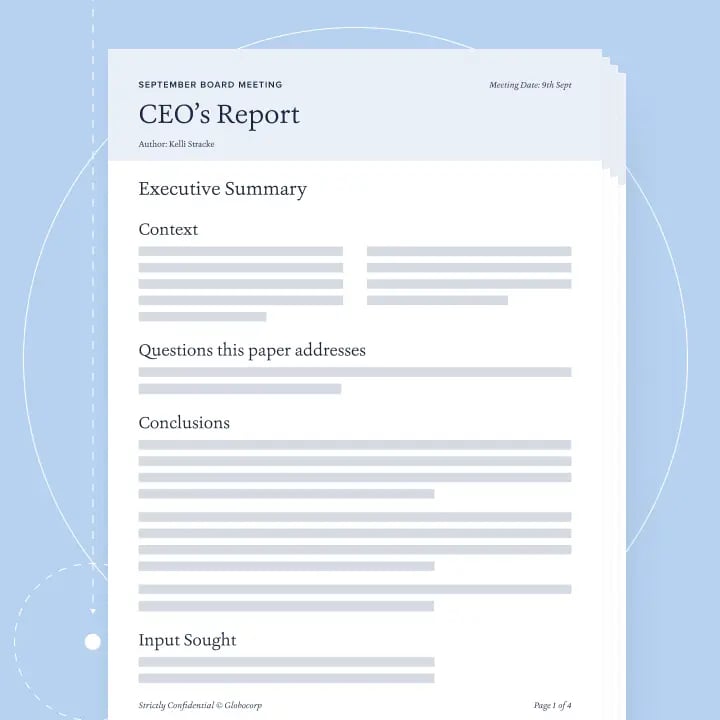In August 1940, as the Battle of Britain raged across the pond, Winston Churchill famously sat down at his desk and wrote a memo to his staff titled “Brevity”, which is still well-known today.
“To do our work, we all have to read a mass of papers. Nearly all of them are far too long. This wastes time, while energy has to be spent in looking for the essential points. I ask my colleagues and their staff to see to it that their reports are shorter.”
Churchill went on to suggest a few tips to cut the word count:
- Using succinct summaries to highlight the key points.
- Putting detailed analysis into appendices.
- Replacing “officialese jargon” with shorter, more conversational phrasing.
“The saving in time will be great, while the discipline of setting out the real points concisely will prove an aid to clearer thinking,” Churchill concluded.
The British statesman was right to be frustrated by the reports landing on his desk. They were wordy and full of muddled thinking, ultimately dimming the readers’ faculties at a time when they needed to be razor-sharp.
Many of today’s business leaders will most likely share Churchill’s frustration. Just look at a typical board pack. These packs are some of the most important documents an organization produces, but they’re often so full of unnecessary “noise” that finding the vital information in them is like looking for a needle in a haystack. According to our research in collaboration with NACD:
- Only 13% of business leaders rate their board packs as “extremely effective”.
- 59% of directors report three or more areas of concern within their board packs.
The same problem often ripples through the organization as a whole, with multiple layers of reporting obscuring vital information from the board and executive committee downwards. This is why poor communication is often described as the “silent killer of big companies”. It makes it difficult to see what matters and even more challenging to get things done.
Why should businesses improve their communication?
There’s no point building a team with exceptional thinking skills if that thinking goes nowhere. If you want to build an enduringly successful organization, you need a team that’s capable of translating its insights and ideas into action.
Your team should be able to express their thoughts succinctly in order to get everyone on board with it.
The problem is that communicating well is difficult, and even those at the highest levels of business struggle with it. In fact, poor communication and miscommunication in the workplace cost US businesses an estimated $1.2 trillion a year.
The good news is that bad communication habits can be unlearned. So, let’s throw away those outdated rules and replace them with some new ones that really work.
Every company has a vast reservoir of brainpower. We’ve written a book to show you how to tap into it.
Find out moreWhat does great communication look like?
For the past 15 years, Board Intelligence has worked with thousands of business leaders and hundreds of organizations to develop the QDI Principle, a methodology for high-quality thinking and writing.
Next time you’re writing a management report or preparing a presentation for your team, try applying these three simple QDI Principle rules, and watch your work shine.
1. Make the key messages crystal clear by putting your bottom line up front
Traditionally, we’re taught to deliver key messages and sum things up at the end. But critical information needs to be highlighted early on, not hidden away in your conclusion.
Instead, put the bottom line up front to help your readers immediately understand your key messages. This means starting with a snappy executive summary that directly answers their questions.
Give a succinct answer to these questions first and treat each one like an elevator pitch. If you only had a few seconds to explain what you think and why your audience should care, what would you say?
2. Make your content easy to follow by writing like a human
Don’t complicate things by trying to sound too smart. This leads to long sentences, multi-syllable words, and jargon, which all put extra strain on our working memory and make the writing hard to process.
Use short, simple words and sentences. This will make your writing easier for readers to understand (and incidentally make you sound smarter too). Numerous studies across countries and cultures, including Princeton and the University of Tokyo, have found that when scoring an author’s intelligence based on a passage of text, those who use shorter words and sentences are rated the highest.
3. Build trust by using your voice
Business writers often hide behind the passive voice and write in the third person in order to sound more formal. But to the reader, this can come across as lacking confidence or avoiding accountability.
To avoid this, rather use the first-person, active voice. When you own your message (for example, saying “We missed our sales targets” instead of “Sales targets were missed”), you show accountability. This is crucial for getting others to trust you and give you the support and resources you need.
How do you stick to these new communication rules?
Unfortunately, knowing what you should do isn’t always enough to change your behavior. Even Churchill struggled to change his team’s bad communication habits. Eleven years after writing the “Brevity” memo, he sent out another directive:
“In 1940 I called for brevity. Evidently I must do so again. I ask my colleagues to read what I wrote then… and to make my wishes known to their staff.”
Churchill didn’t realize that a memo doesn’t automatically translate to a culture of improved communication.
So, what does?
The key to making an organization communicate well is making it difficult to communicate poorly. The companies that do this best don’t rely on memos, style guides, role modeling, training, or copy editors. They harness technology to show people when they’ve missed the mark and help them to improve.
This is similar to the Japanese concept of poka-yoke, or “mistake-proofing” — designing a product or process in a way that makes it really difficult to mess up. The term was first coined in the 1960s on Japan’s manufacturing floor, and applications can be seen today in most modern manufacturing processes, as well as daily life. Examples include automatic cars that won’t start if they’re not in “park” or “neutral”, and filing cabinets that won’t let you open more than one drawer at a time.
Today’s software tools can be used in the same way. Many of us already use them to check our spelling and grammar, but we can take things a step further by using software to nudge teammates to adopt the communication principles that work.
This is where artificial intelligence can help. AI’s incredible capabilities to analyze and rephrase copy can push report writers in the right direction, acting as an always-on-call editor and friend.
That’s why we built Lucia, an AI-powered thinking and writing guide. This is poka-yoke in action.
Lucia can give instant feedback and real-time prompts that challenge writers on their words of choice, nudging them in the right direction and training them as they go. Are sentences short and concise enough? Is the vocabulary simple and jargon-free? Lucia’s AI tools will ask these questions and suggest how to fix any issues it finds.
Soon, these new communication conventions will feel less like “new rules” and more like “good habits” that are hard to break. This transforms communication into an organizational superpower rather than a hindrance, helping you channel your team’s collective thinking and apply it where it matters most.
Ready to start building better communication habits?
To tap into better communication, take a look at Lucia, our AI-powered management reporting software. It offers live feedback, real-time prompts, smart automatic editing tools, and much more.
Additional resources:
See our guides below to learn more and find out how to apply these principles to specific papers.
How to…




